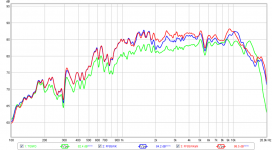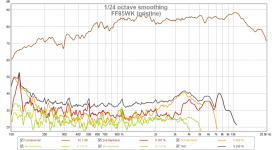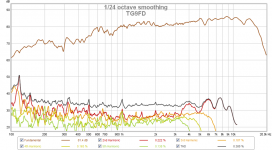+1>>> How about using the full range driver full range? Just put it in a large enough sealed box and call it good.
Since it's just the Fostex driver, building an optimal box and just swapping drivers might actually be better. It removes another variable (crossing the driver to the woofer).
But only for this comparison.
>>> I've never claimed any other cabinet I've ever done is optimal for that matter...
Scott, I have enjoyed examining all of your designs. As a whole, they're awesome. Individually, beautiful.
Thank you.
Scott, I have enjoyed examining all of your designs. As a whole, they're awesome. Individually, beautiful.
Thank you.
Jeff - building some of the larger manifolds is an exercise is patience, and often requires several hours physio after moving them about. The FH series have got to be my favorite performers - just wish I had the room for the FHXLs on a daily basis.
FF85WK and FF85WKeN measurements
I installed the drivers in a vented Dagger TL with a trapezoidal baffle. I also took measurements of a TG9FD for reference. This measurement was made using a TPA3116D2 class D amp and a UMM-6 microphone. The driver is fed by a passive XO consisting of a 57uF high pass filter and a 5R+5R divider and a RC Zobel.
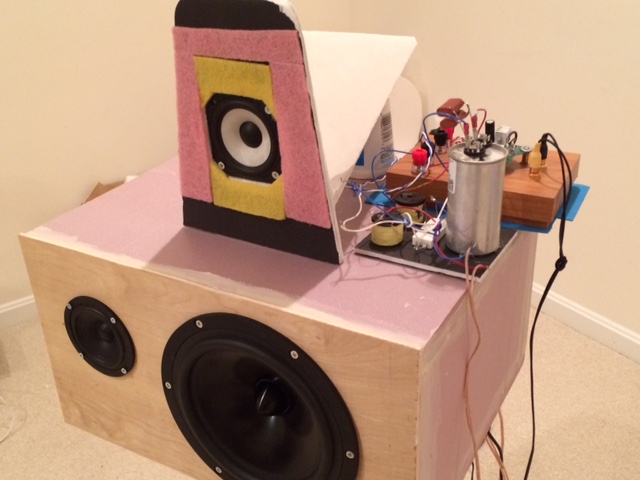
All:
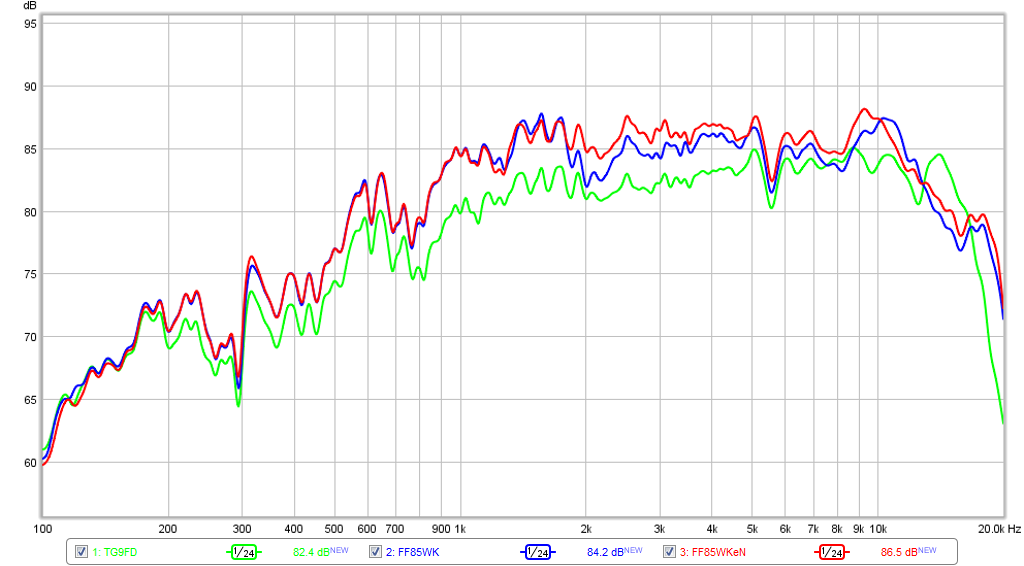
HD of FF85WK (pristine stock driver, not broken in):
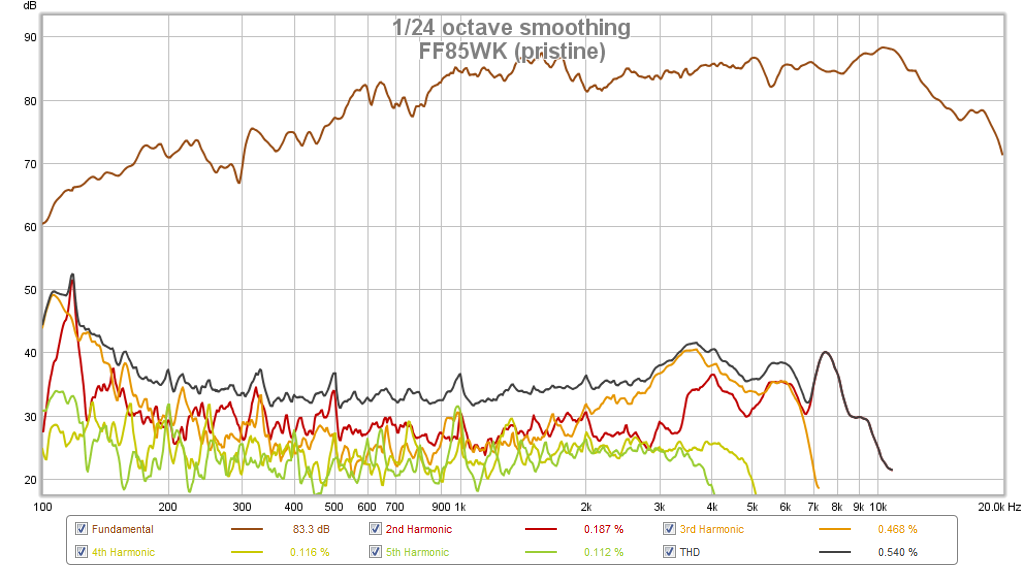
FF85WKeN (provided by Planet10):
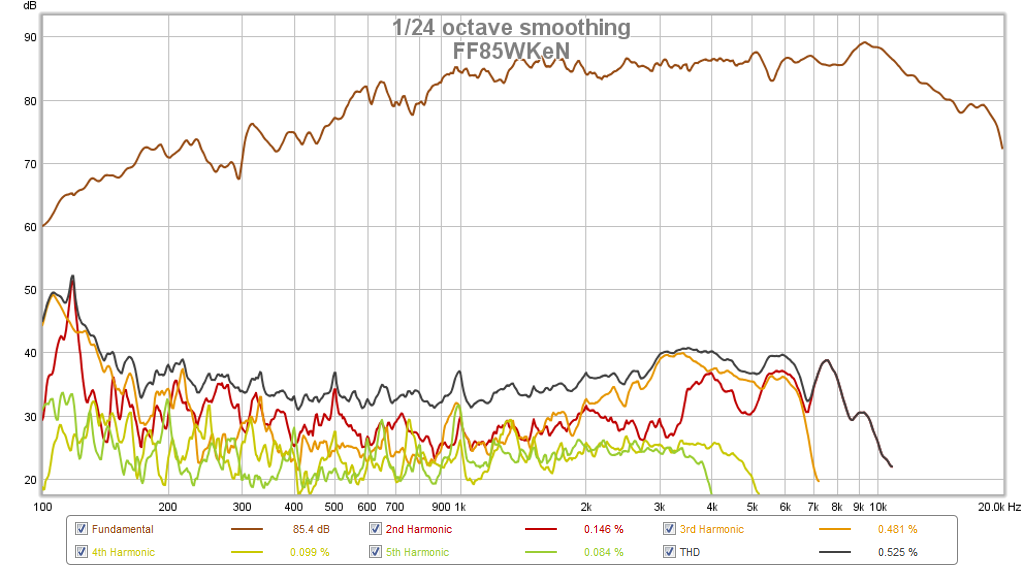
Here is HD of TG9FD for reference:
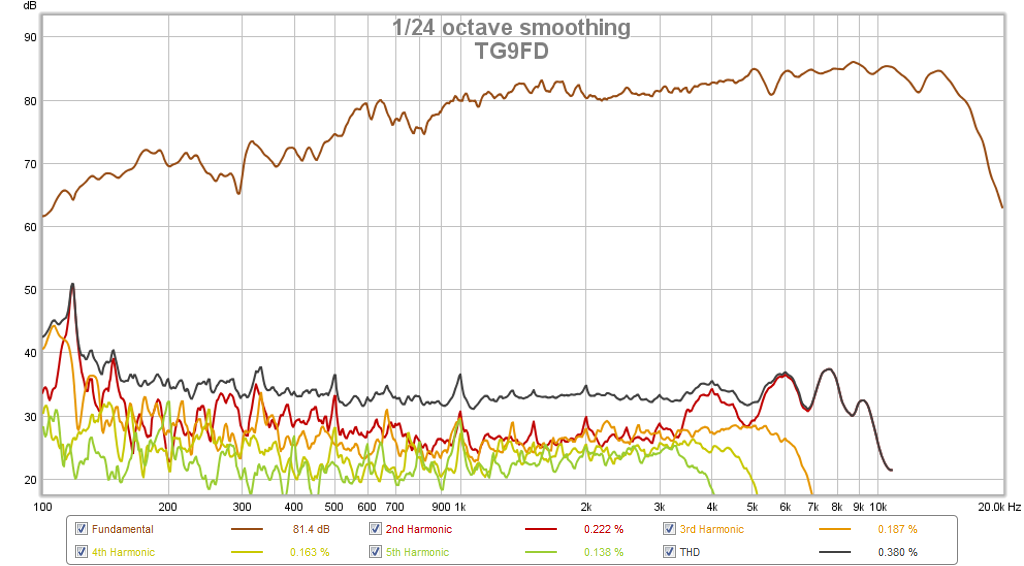
There appears to be a measurable difference in increased sensitivity and smoothness with the eNabled one. This will obviously, be audible in my opinion.
I installed the drivers in a vented Dagger TL with a trapezoidal baffle. I also took measurements of a TG9FD for reference. This measurement was made using a TPA3116D2 class D amp and a UMM-6 microphone. The driver is fed by a passive XO consisting of a 57uF high pass filter and a 5R+5R divider and a RC Zobel.

All:

HD of FF85WK (pristine stock driver, not broken in):

FF85WKeN (provided by Planet10):

Here is HD of TG9FD for reference:

There appears to be a measurable difference in increased sensitivity and smoothness with the eNabled one. This will obviously, be audible in my opinion.
Attachments
Last edited:
I installed the drivers in a vented Dagger TL with a trapezoidal baffle. I also took measurements of a TG9FD for reference. This measurement was made using a TPA3116D2 class D amp and a UMM-6 microphone.

All:

HD of FF85WK (pristine stock driver, not broken in):

FF85WKeN (provided by Planet10):

Here is HD of TG9FD for reference:

There appears to be a measurable difference in increased sensitivity and smoothness with the eNabled one. This will obviously, be audible in my opinion.
So a couple questions.
1) is that with the 600hz crossover? It seems to start rolling off at 1khz which seems odd without a crossover
2) could you record the left and the right simultaneously potentially to record the actual stereo?
3) have you done any far-field distortion measurements comparing identical foam boxes and wooden boxes to see if there's a measurable difference? I'd be interested in both if there's a measured difference and actually building the speakers and seeing if it's audible
Yes, there is a XO high pass filter in place. Recording in stereo does not result in a good sound for comparison as the room effects dominate. You hear the ambient lack of room acoustic treatments more than the effect of the driver and its eNabling. I have measurements showing how adding CLD using latex caulking and another sheet of foam core makes a huge difference in some speakers. -30dB reduction in the rumble noise that we see manifest as distortion.
Last edited:
Interesting!
There are clearly some differences.
The biggest and probably most important difference is the smoothing and uplift of the valley at 2-3 K. Our ears are the most sensitive to irregularities and distorsion in this frequency range.
X. Would you mind telling us what mods besides Enb. the Planet 10 driver has?
A photo would be nice to. 😉

There are clearly some differences.
The biggest and probably most important difference is the smoothing and uplift of the valley at 2-3 K. Our ears are the most sensitive to irregularities and distorsion in this frequency range.
X. Would you mind telling us what mods besides Enb. the Planet 10 driver has?
A photo would be nice to. 😉

Any thoughts on why enable would increase sensitivity? It seems counter-intuitive from an increased-cone mass perspective. Is it because it increases the Quality (stiffens) of the cone?
Don't "blame" enabled for all of the differences. I'm pretty sure the other mods Dave applied do something as well. I can see the frame mods increasing sensitivity by taking away resonances in the driver's frame.
So this isn't a comparison of enabled vs untreated. It's more Dave's mod package vs untreated.
It would be interesting to see the other pair of drivers measured as well.
So this isn't a comparison of enabled vs untreated. It's more Dave's mod package vs untreated.
It would be interesting to see the other pair of drivers measured as well.
Interesting!
There are clearly some differences.
The biggest and probably most important difference is the smoothing and uplift of the valley at 2-3 K. Our ears are the most sensitive to irregularities and distorsion in this frequency range.
X. Would you mind telling us what mods besides Enb. the Planet 10 driver has?
A photo would be nice to. 😉

Yes, most interesting indeed. Given that there measurable differences I don't think it's going to be much of a controversy if we are able to tell a difference. The slight rise in region affected affects the "presence" zone of the driver and certainly the eN will sound a bit more "forward" and "lively". These are the things done by P10 when one buys these drivers:
1. The TS parameters are matched within about 5% for a pair.
2. They receive bench top break-in of X-hrs (80hrs ?).
3. Putty on the frame mainly to smooth out the rear wave airflow and secondary to dampen vibrations of the rather thin metal frame.
4. The eNabled treatment of dots and a clear conformal coat of something (Modpodge?)
P10 can correct me if I missed anything or got something above wrong. But I have to say - they do sound very nice played in my FAST setup. Compared to the TG9FD, they are quite a bit more sensitive - and this would be one reason one might call the TC9/TG9FD "lifeless" in comparison. However, adjusted for same base SPL at say 1kHz, the TG9 looks to be smoother with an uplift in the treble and might sound more resolving and smoother. So the dilemma will be should I assume that P10's treatments increase the sensitivity or is that a manufacturing variability? That one factor alone is significant and will make the blind listening test rather trivial to select the "right" one for ABX matching. However, if I rebalanced for identical SPL at a baseline point - can we hear the differences? There still are changes in frequency space if you look at the 10KHz peak it is shifted.
But if the point is to see if one can hear an audible improvement between the two sets of drivers I have - based on the measurements here, I would say a definite yes.
Thanks for the measurements X! Assuming the drivers measured the same stock and the differences are from the treatments and not from extended break in then it's clear to see the tweaks work.
We are a DIY community. We trust in our ears.
Well done X and P10. Thanks for sharing!
We are a DIY community. We trust in our ears.
Well done X and P10. Thanks for sharing!
X, what db were the harmonic measurements taken at? The measurement says 83db, was that at half a meter? Also interesting that there are significant measurable differences. Have you measured the difference between the two normal drivers and the two enabled drivers to see if there's much variance between them? I guess there wouldn't be much between the enabled supposedly. I'd be surprised if that sensitivity is due to manufacturing tolerances as 2dB is plenty to throw channel balance off in a stereo setup
Also Dave I'm pretty sure I've heard before that your process can improve sensitivity. Do you know what the mechanism behind this is?
X, what db were the harmonic measurements taken at? The measurement says 83db, was that at half a meter? Also interesting that there are significant measurable differences. Have you measured the difference between the two normal drivers and the two enabled drivers to see if there's much variance between them? I guess there wouldn't be much between the enabled supposedly. I'd be surprised if that sensitivity is due to manufacturing tolerances as 2dB is plenty to throw channel balance off in a stereo setup
Yes, the SPL is absolute calibrated and at half a meter. I will have to measure what the actual rms drive voltage is, but at 0.5m, to get same sensitivity as at 1m would require -6dB on drive voltage. So a good reference level would be 2.83v - 6dB or 0.71v. There is small 3H distortion bump at 3.5k that is shifted to 3.1k with the eN one:


It's at a rather low level here but if I were to take this up to 95dB at 1m, there would be a noticeable peak there I think.
Interesting. I'd be interested to see a higher level measurement more around 95dB at 1/2m or maybe even 100db. I should have the driver myself soon enough with a nice mic too to do my own measurements but I think it's interesting to see how the driver distorts into dynamics. From what I see at this level it's my opinion that I think a first order suffers from too much low level excursion. Since the fs for this driver is down around 100hz you get maximum excursion/distortion at around 100hz even when that is way below the targeted 600hz pass band and I think with a higher drive level I think it would become apparent that the distortion at 100hz would probably start to approach or exceed the fundamental which would really muddy up the higher frequencies and lead to more intermodulation distortion.
I haven't had much experience with time aligning drivers though. Is it really as valuable as people make it out to be? To me it seems that proper crossover design with a second order and close driver proximity gives many benefits in excursion/distortion and lower crossover point without too many downsides. Sorry for my sidetrack haha just Interesting stuff to me. Feel free to ignore me and carry on with the intended purpose of the thread lol
I haven't had much experience with time aligning drivers though. Is it really as valuable as people make it out to be? To me it seems that proper crossover design with a second order and close driver proximity gives many benefits in excursion/distortion and lower crossover point without too many downsides. Sorry for my sidetrack haha just Interesting stuff to me. Feel free to ignore me and carry on with the intended purpose of the thread lol
Would you mind telling us what mods besides Enb. the Planet 10 driver has?
FF85wk get a pre-coat of thin puzzlekoat, a treatment with ZIG 2-way glue on the back at the juncture of the surround/cone, the ductseal to shape the rear exit, and pairs are matched.
dave
Interesting!
There are clearly some differences.
The biggest and probably most important difference is the smoothing and uplift of the valley at 2-3 K. Our ears are the most sensitive to irregularities and distorsion in this frequency range.
Yes, interesting. Improved freq response in that freq range indicates to me that a wave reflection null from the impedance mismatch at the cone/surround interface has been reduced. That's my theory anyway, and it makes sense given that IIRC the basic rationale of enable dots is to improve wave termination at the edge of the cone.
Once again, thanks for the research xrk971! 😀
1. The TS parameters are matched within about 5% for a pair.
2. They receive bench top break-in of X-hrs (80hrs ?).
3. Putty on the frame mainly to smooth out the rear wave airflow and secondary to dampen vibrations of the rather thin metal frame.
4. The eNabled treatment of dots and a clear conformal coat of something (Modpodge?
P10's treatments increase the sensitivity or is that a manufacturing variability?
1/ I have a metric that is composed of T/S. A driver has to meet +/- 3% and have a sensitivity within 0.25 dB.
2/ a minimum of 200 Hrs at low level
3/ ductseal
4/ the conformal coating is part of the EnABL process and is a gloss acrylic.
The treatment decreases sensitivity by a small amount.
I have here 2 sets of uFonkenPlus with matched stock & treated drivers matched to within 0.1 dB.
dave
a higher level measurement more around 95dB at 1/2m or maybe even 100db.
A steady tone that loud will exceed the (next to meaningless) power handling of the driver.
dave
- Status
- Not open for further replies.
- Home
- Loudspeakers
- Full Range
- Planet 10 measured improvements? FF85wk
